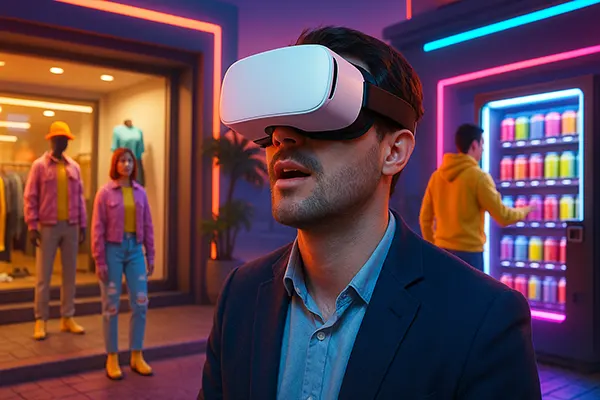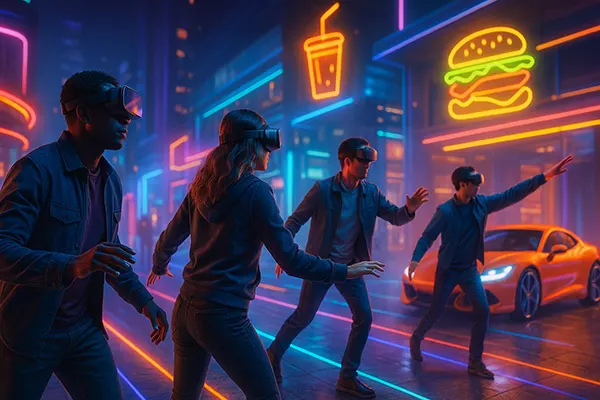
Metaverse and “Black Marketing”: How Brands Manipulate in VR Spaces
The metaverse has become more than just a futuristic concept. By 2025, it is an expanding environment where social interactions, commerce, and digital identity converge. With these developments, new ethical challenges arise. One of the most pressing issues is the emergence of so-called “black marketing” – hidden, manipulative advertising practices that blur the boundaries between reality and virtual space. This article explores real cases, transparency issues, and how regulators are preparing to respond worldwide.
Hidden Brand Promotion in the Metaverse
Brands are increasingly exploring VR environments to reach new audiences. However, not all approaches are transparent. In several virtual worlds, companies have introduced avatars wearing branded items without explicitly labelling them as advertisements. This practice, resembling influencer marketing, makes it difficult for users to distinguish between genuine digital identity and paid promotion.
By 2025, large corporations such as Nike and Gucci have invested in virtual fashion lines, while food and beverage companies experiment with VR events. Although some campaigns are openly branded, others employ subtle integrations where logos and slogans appear as part of the game design, without notifying participants that this is sponsored content.
Such strategies raise ethical concerns. Younger audiences are especially vulnerable, as they may not recognise the difference between independent content and commercial influence. This hidden approach has been described as “black marketing” because of its manipulative nature and lack of transparency.
Case Studies of Manipulative Practices
One widely discussed case involves a popular VR social hub where a beverage company placed interactive vending machines that dispensed virtual items. At first glance, they appeared as part of the environment, but users later discovered that they were linked to a brand campaign. Similarly, fashion brands have used NPCs (non-playable characters) to showcase outfits, effectively turning them into virtual product placements without disclosure.
These examples show that manipulation in VR can be far more immersive than in traditional media. Unlike banner ads or TV commercials, brand messages can be woven into the storyline, architecture, and interactions. As a result, consumers may adopt attitudes or preferences without realising they have been influenced by marketing strategies.
Such cases demonstrate why regulators and industry experts call for clearer labelling and the development of ethical guidelines that balance innovation with responsibility.
Transparency and the Blurred Line Between Reality and Virtuality
Transparency is at the heart of the debate. In the physical world, advertising laws require that promotional content be marked clearly. In the metaverse, however, this principle becomes harder to enforce. When an avatar wears a branded jacket, is it an expression of identity, or is it a paid endorsement? The distinction is not always obvious, even to regulators.
Another issue is the psychological effect of immersive advertising. Studies in 2024–2025 have shown that consumers are less resistant to marketing messages when they are part of an interactive experience. Unlike traditional ads, which can be skipped or ignored, VR integrations are more subtle and influence behaviour on a subconscious level.
This creates a double challenge: ensuring consumer protection while maintaining the creative freedom that makes the metaverse attractive. Clearer frameworks are needed to prevent manipulative tactics from dominating virtual spaces.
The Role of Ethical Standards
Industry leaders and academic experts have begun calling for new ethical codes specific to the metaverse. These standards include mandatory disclosure of paid integrations, limits on targeting vulnerable groups such as children, and ensuring that advertising does not mislead users about the nature of the content.
Some tech companies have already started experimenting with voluntary labels for branded experiences, similar to “sponsored” tags on social media. However, these efforts are not yet consistent across VR platforms, creating loopholes that can be exploited by aggressive marketers.
The long-term credibility of the metaverse depends on finding a balance. If consumers feel constantly manipulated, the trust in digital environments could decline, limiting growth and innovation.

Regulatory Responses in Different Regions
Governments and international organisations are actively considering how to regulate advertising in virtual spaces. The European Union has extended its Digital Services Act to cover immersive technologies, stressing the importance of transparency and consumer rights. By 2025, several EU member states are drafting additional rules on disclosure in VR environments.
In the United States, the Federal Trade Commission (FTC) has issued guidelines that virtual endorsements and in-game promotions must be clearly labelled. Enforcement remains challenging, but the intention is to apply the same principles that already exist in digital marketing.
Asian regulators are also paying close attention. South Korea and Japan, where VR adoption is particularly high, are developing frameworks that combine innovation incentives with strict rules against deceptive practices. China, meanwhile, focuses on heavy content monitoring, ensuring that commercial and political influences in VR remain under state oversight.
Future Outlook and Global Standards
The path forward will likely involve international cooperation. Advertising in VR is inherently borderless: a user in Europe may interact with a virtual product created by a brand in the United States or displayed in an Asian VR world. This creates a need for harmonised rules that ensure consistency and fairness globally.
Experts suggest that future global standards could resemble those in traditional advertising, with a combination of disclosure, age restrictions, and penalties for manipulative campaigns. Without such standards, brands may continue to exploit loopholes, leading to mistrust and backlash from consumers.
By 2025, the debate around black marketing in the metaverse has reached a critical point. Regulators, brands, and users must collectively decide how to shape virtual environments so that they remain creative, engaging, and trustworthy rather than manipulative and exploitative.
Similar news
-
 How Fake Review Networks Operate in 2026: Real ...
How Fake Review Networks Operate in 2026: Real ...Fake review networks have moved far beyond “a few paid …
-
 How Brands Should Handle Negative Mentions in G...
How Brands Should Handle Negative Mentions in G...AI-generated answers in Google and Bing have changed how brand …
-
 Brand Strategy in Times of Change: Building Lon...
Brand Strategy in Times of Change: Building Lon...Organisations entering 2025 face markets shaped by rapid technological shifts, …
